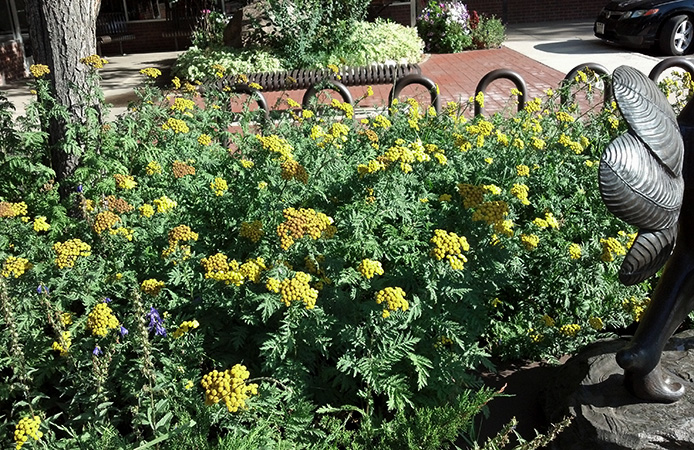Jointed Goatgrass
Aegilops cylindrica
Keys to Identification
- Annual grass
- 15-30 inches tall
This information courtesy of the Colorado Natural Areas Program
Family
Grass (Poaceae)
Other Names
Goatgrass
USDA Code
AECY
Legal Status
Colorado Noxious Weed List B
Identification
Lifecycle
Annual
Growth form
Grass
Flower
The seed head is 2-4 in long with 5-10 spikelets (joints) per head. Early to mid-June.
Seeds/Fruit
Spikelets are 0.5 in long with 1-3 viable seeds. At maturity spikelets separate with a segment of the stems still attached.
Leaves
Leaves are alternate, simple, with a flap-like appendage (auricle) at the base, and a leaf blade 0.17-0.25 in wide, with hairs.
Stems
Mature plants are generally 15-30 in tall with one to many tillers.
Roots
Short fibrous root system.
Similar Species
Exotics
Similar in appearance, and genetically related to, winter wheat.
Natives
N/A
Impacts
Agricultural
Jointed goatgrass has become a very serious weed in winter wheat and other cereal crops. Its genetic similarity, and similar growth characteristics to winter wheat make it very difficult to control without adversely harming crop production. Jointed goatgrass also infests rangeland surrounding wheat growing areas and land in the Conservation Reserve Program throughout the western United States.
Habitat and Distribution
General requirements
It can flourish in areas of 10-20 in annual rainfall.
Distribution
Jointed goatgrass is found throughout the western United States at elevations up to 6,000 ft.
Historical
Jointed goatgrass is thought to have been introduced from Turkey in contaminated wheat.
Biology/Ecology
Life cycle
Jointed goatgrass flowers in early to mid-June. Some jointed goatgrass seeds germinate early and the remainder of the seeds may persist in the soil for years. Jointed goatgrass seeds usually germinate from early August – October but they can also germinate in late spring and still mature if temperatures are low enough.
Mode of reproduction
Seed.
Seed production
A jointed goatgrass plant can produce up to 100 spikes, 1,500 spikelets and up to 3,000 seeds.
Seed bank
Soil moisture plays an important role in jointed goatgrass seed viability and dormancy. Regardless of conditions, jointed goatgrass seeds rarely remained viable for over five years in the soil.
Integrated Management Summary
Studies have shown that jointed goatgrass, winter wheat, and downy brome all compete for nutrients, moisture, and light. Comparatively, winter wheat is usually more competitive than jointed goatgrass, and both are much more competitive than downy brome. Jointed goatgrass also has a faster growth rate than downy brome. This faster growth rate, plus the use of herbicides that are more effective controlling downy brome than jointed goatgrass, may result in a weed species shift from downy brome to jointed goatgrass. An integrated management strategy should focus on preventing the establishment of new infestations in suceptible areas, and depleting the soil seed bank.
References
Lyon, D.J. 1998. Jointed Goatgrass Biology. Internet 07/28/98. www.ianr.unl.edu/jgg/billings/lyonbiol.htm
Morishita, D.W. 1998. Biology of Jointed Goatgrass. Internet 07/28/98. www.ianr.unl.edu/jgg/conf/morish2.htm
Stahlman, P.W. 1998. Jointed Goatgrass Control Methods – A Review. Internet 11/12/98. www.ianr.unl.edu/jgg/stahlman.htm
Whitson, T.D.(ed.), L.C. Burrill, S.A. Dewey, D.W. Cudney, B.E. Nelson, R.D. Lee, R. Parker. 1996. Jointed goatgrass. Weeds of the West. Western Society of Weed Science, in cooperation with the Western United States Land Grant Universities Cooperative Extension Services, Newark CA . pg. 408.


